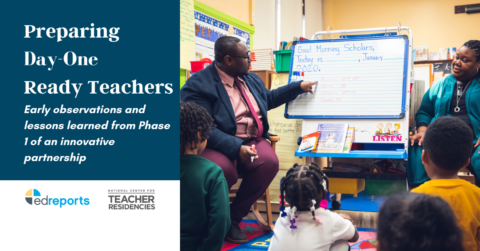Pilot Program Seeks to Train New Teachers to Recognize and Use High-Quality Instructional Materials, Building Their Curriculum Literacy
The National Center for Teacher Residencies and EdReports partner to fill an unmet need in the field of teacher preparation.
Related Resources
article
Preparing Day-One Ready Teachers
The National Center for Teacher Residencies and EdReports highlight Phase 1 learnings from an innovative new pilot program to infuse curriculum literacy into teacher preparation.
article
Centering Quality Materials in Teacher Preparation Programs
Veteran educators share advice on how to reimagine teacher prep to ensure curriculum literacy.
video
Watch: How Family Engagement and HQIM Benefit Teachers, Students, and Caregivers
Megan Lorio and Elisabeth O’Bryon of Family Engagement Lab share tips and insights on how districts, teachers, and caregivers can unite around high-quality materials to help every student thrive.


